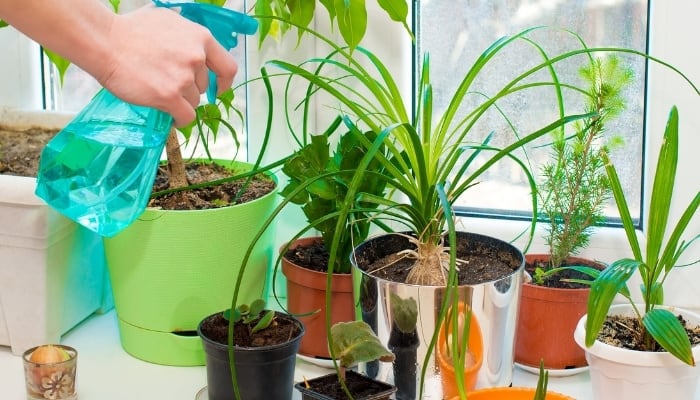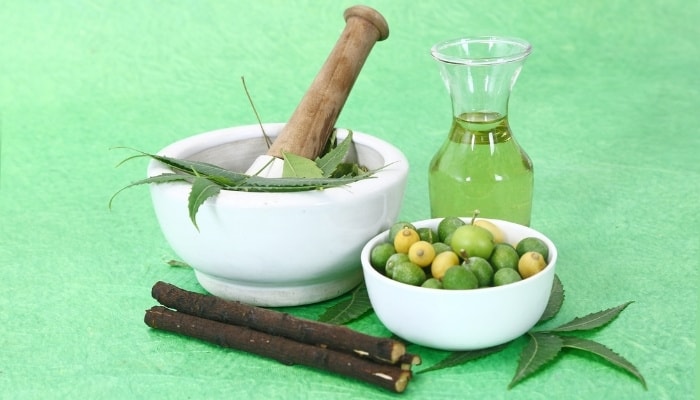Are you having trouble with pests damaging your indoor plants? Concerned about using chemical products in your natural garden?
Neem oil is a natural oil derived from the seeds of the neem tree or Azadirachta indica, which grows in India and Sri Lanka.
It is a broad-spectrum miticide, insecticide, pesticide, and fungicide that can be safely used in your indoor or outdoor garden and around pets.
The oil is also widely used in beauty products to treat skin and hair.
This article will explain how to use neem oil for houseplants to keep them healthy and free of diseases and pests.
We’ll also explain the precautions that you should pay attention to and when not to use this oil, so keep reading to learn more about this topic.
Neem Oil for Houseplants
Despite being highly versatile in traditional Indian medicine as a beauty product, neem is popular for its potency in treating plant pests and diseases.
In addition, it’s approved by the US EPA as a safe pesticide when used alone or mixed with other ingredients because it’s compatible with the standards of organic farming and doesn’t harm house pets.
What Does Neem Oil Do for Plants?
Neem oil can be used as a preventative method as well as a treatment for an existing problem in your indoor and outdoor garden.
Unlike other chemical insecticides and pesticides, neem oil is an organic product that doesn’t have a toxic effect on the natural environment.
The best thing about neem oil is that, unless it’s directly sprayed on them, neem oil won’t affect pollinators like bees and butterflies.
It will only affect the bugs that harm your plants throughout their life cycles.
One of the best ways to use neem oil is to apply it as a soil drench until it gets absorbed by the roots of the plant.
You can also use neem oil sprays directly on the infected parts of the plant, where it clogs the bugs’ airways, eventually suffocating them.
Pests
Pure neem oil contains Azadirachtin, which affects the bodily functions of pests and insects, eventually killing them.
The same effect is obtained from clarified neem oil and neem cakes, which are the solid leftovers from extracting the oil.
Neem oil can affect hundreds of harmful pests and, at the same time, doesn’t affect helpful bugs like ladybugs and bees. It has a stronger effect on soft-bodied insects.
You can use neem oil to fight off the following insects and bugs:
- Ants
- Aphids
- Beetles
- Cabbage worms
- Black-headed caterpillars
- Grubs
- Cockroaches
- Flies
- Gnats
- Grasshoppers
- Lace bugs
- Mealybugs
- Locusts
- Moths
- Mites
- Termites
- Thrips
- Whiteflies
The toxic effect of neem oil doesn’t extend to the animals, birds, or insects that prey on these pests.
It affects the hormones in pests and insects, eventually controlling an infesting population because the adult insects are unable to reproduce.
Diseases
Neem oil can kill fungal diseases affecting outdoor and indoor plants like leaf spot, black spot, scab, and powdery mildew.
These diseases don’t kill your plants but usually attack vegetables and fruits and affect their production.
The clarified hydrophobic extract of neem oil is one of the best treatments for fungal diseases, especially when mixed with diluted dish soap and water.
It’s more potent when applied when the first symptoms appear.
Shining Plant Leaves
Neem oil can be used to shine and clean your plant leaves. It gives them a radiant look and adds a protective coat that protects your plants from pests and fungal diseases.
To shine your leaves, you need to prepare an emulsion of diluted dish soap, neem oil, and water.
Only 4 teaspoons of neem oil will be needed for a gallon of water. Add a tablespoon of dish soap to remove all the dirt and dust from your leaves and make them look shiny and healthy.
Spray this cleaning solution on a soft microfiber cloth, and use it to wipe the leaves of the plants. Wipe the leaves’ top, underside, and stems to ensure they’re clean.
What Plants Not To Use Neem Oil On
Herbs and some plants have delicate or wispy leaves, and using neem oil will lead to foliage burns.
Even if the plant is tolerant of neem oil, using it too often or when the sun is too hot can also lead to foliage burns.
If you grow these neem-sensitive plants in your garden, you can use insecticide soap because using neem oil can cause too much harm to the plant.
Here are some plants that you shouldn’t use neem oil on:
- Basil
- Arugula
- Dill
- Lettuce
- Caraway
- Oregano
- Rue
- Marjoram
- Cilantro
- Thyme
- Parsley
- Chives
- Sage
- Peas
- Spinach
How Often To Use Neem Oil on Houseplants
Neem oil is a potent insecticide and pesticide, but it can also kill some plants if they’re too delicate or too young or the oil is used heavily and too frequently.
This is why you must dilute it before applying and testing how your plant will react to it.
In order to use neem oil, you need to test it on a small patch of your plant and then wait for 24 hours. If the plant seems fine, you can proceed with a complete application.
Applying neem oil in the evening for outdoor and indoor plants is recommended because the sunlight can make the oil burn the foliage.
You can reapply the oil every seven to 14 days, depending on the severity of the infection.
Too Much Neem Oil for Plants
Neem oil takes time to work, so if you still see bugs infesting your garden, this doesn’t mean that you should apply it again too soon.
It’s recommended to use neem oil as a preventative treatment every two weeks and to treat fungal diseases and pests every week.
The oil should also be diluted with water and mixed with soap so that it doesn’t burn the leaves.
Applying neem oil too often will kill the bugs but will also burn your leaves and eventually kill your plant.
Precautions When Using Neem Oil for Houseplants
It’s essential to test neem oil and apply it adequately to kill the pests and insects without harming the plant itself. Here are some precautions to consider:
- Understand that neem oil has a strong smell and can be irritating when used on indoor plants. So, wear a mask, and keep the area well ventilated while applying it.
- Test the neem oil on one of the leaves and leave it for 24 hours before a full application. You can also wait for one week to see if the leaves change color.
- Follow the instructions if you’re buying a neem oil spray, and keep it away from heat, direct sunlight, pets, and children.
Best Neem Oil for Houseplants
You can use concentrated neem oil or ready-to-use versions. The ready-to-use sprays are more practical and suitable for beginner gardeners.
However, you need to make sure that you’re buying an actual oil and not an extract.
Most neem oil extracts contain little or no Azadirachtin, the potent chemical component in neem oil.
So, although they might add shine to your plants, they won’t be effective in dealing with pests and fungal diseases.
The concentrate is too strong to be used directly on the plant, so you need to dilute it first.
Plantonix Organic Cold Pressed Neem Oil
This is an efficient solution for those who need high-quality neem oil. It contains organic neem oil with no other additives, so it’s even safe for hair care and skin care.
This cold-pressed oil retains all its chemical properties, so it’s an excellent choice for your indoor and outdoor garden.
How To Dilute Neem Oil for Plants
Preparing neem oil spray for your plants is easy if you follow these steps.
- Make sure that you have access to high-quality cold-pressed neem oil.
- Mix 1 liter of warm water and 1 teaspoon of mild dish soap in a spray bottle.
- Shake the bottle well to make sure that the soap is completely dissolved.
- Add 1 teaspoon of neem oil and shake again.
- Apply the neem oil to the infested and infected areas. If the infestation is too strong, add another teaspoon of neem oil to the mixture.

Neem Oil Soil Drench
The same mixture you used to spray your plant leaves can be used as a neem oil soil drench.
This is when the plant roots absorb the neem oil or the Azadirachtin compound, which gets distributed throughout the plant’s entire system.
As a result, any pest feeding on any part of the plant will be subject to this chemical compound and will eventually die.
At the same time, the soil drench will make the plant resistant to fungal diseases.
Neem soil drench can be used on fruit trees and many, many other plants and trees. It doesn’t affect beneficial creatures like earthworms and won’t harm snails and slugs.
How To Use Neem Oil for Houseplants
The following method will help you prepare a neem oil spray or soil drench to protect and treat your plants from pests and fungal diseases.
- Mix 1 to 1 1/2 teaspoons of neem oil concentrate with 1 teaspoon of dish soap and a liter of water.
- Put the ingredients in a spray bottle, and shake it well.
- Spray one or two leaves of your plant with the neem oil spray, and wait between one and seven days to see if your plant is neem-oil tolerant.
- Keep the plant away from direct sunlight after the application.
- Apply the spray in the evening and keep indoor plants away from direct sunlight during and after the application.
- Spray your plant with neem oil, applying it to the leaves’ top and bottom. Also, apply the spray to the stems.
- Spray the mixture every one to two weeks until the infestation is gone.
- For heavy infestation, use insecticidal soap before using the neem oil spray.
- Once your plant is healthy, use the spray to add shine to the leaves and as a preventative treatment.
A Quick Look Back
Neem oil is a natural treatment that gets rid of pests and fungal diseases. It also adds shine to your plant leaves.
Whether you use it as a soil drench or a foliage spray, don’t overapply neem oil because it can burn your plants. The results usually take several weeks to appear, but they’re long lasting.

